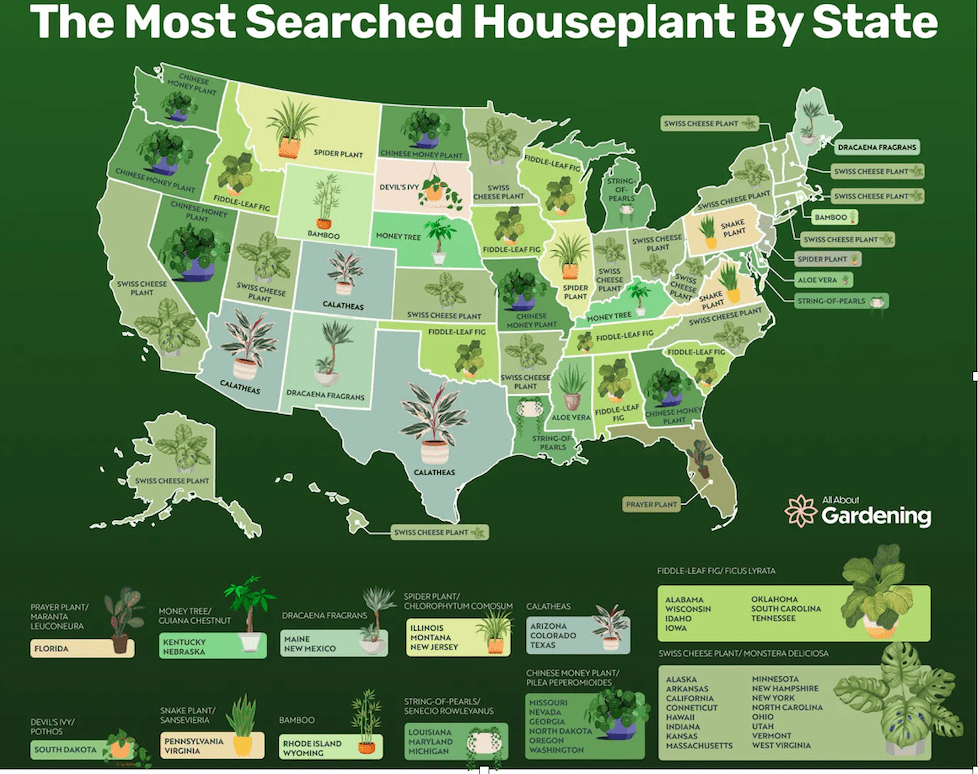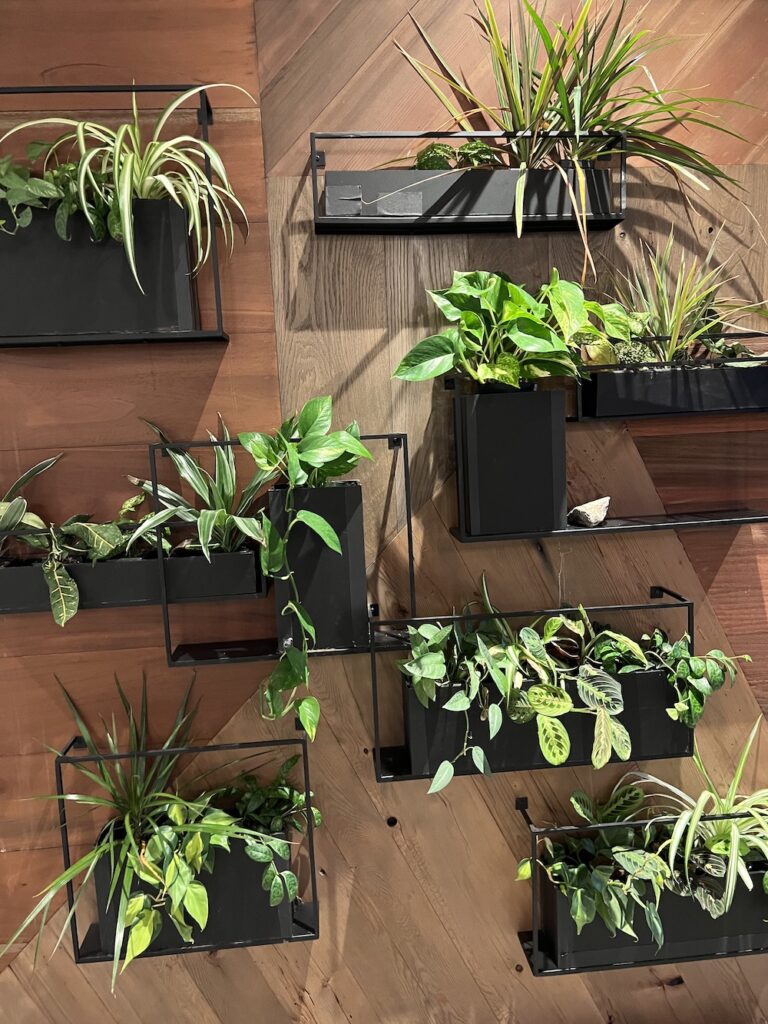Most POPULAR U.S. Houseplants – State by State
By Jill Brooke

Research conducted by AllAboutGardening.com analyzed Google Trends data to establish the most Googled houseplant in each American state in the past five years. And guess which one won? The Monstera plant, commonly known as the Swiss cheese plant, is the most popular across the nation.

It is also a popular leaf to use in many tropical floral arrangements like those by Beyonce florist Oscar Mora.
But getting back to the study, here are some other details.
The analysis revealed that the Monstera deliciosa had the highest number of states searching for it the most, with a total of sixteen American states, including New York, Ohio, California, and Hawaii. The Monstera deliciosa, more commonly known as the Swiss cheese plant is incredibly popular mainly due to the fact that it’s relatively easy to take care of and rarely gets any diseases – ideal for anyone wanting to get into houseplants.

Other popular houseplants by state
A Ficus lyrata, otherwise known as a Fiddle-leaf fig, was the second most popular houseplant with seven states searching for it more than any other houseplant, including Oklahoma, Wisconsin, South Carolina and Tennessee. The plant that can grow up to ten feet tall is a popular choice with the plant thriving in bright spots that aren’t in direct sunlight, making them perfect for many spots throughout the home.
A total of six states searched for a Pilea peperomioides (Chinese money plant) the most, the third-highest number in the research. States with residents searching for the Chinese money plant the most include North Dakota, Oregon, Nevada and Washington. The Pilea peperomioides is perfect for smaller homes as the plant tends to only need a small pot and is similar to the Ficus lyrata in that it likes bright light but not direct sunlight.
- Three houseplants came joint fourth, with three states searching for each of them the most respectively – these plants being a Senecio rowleyanus (String-of-pearls), Chlorophytum comosum (Spider plant), and Calatheas.
- The Senecio rowleyanus, otherwise known as a String-of-pearls, was the most searched for a houseplant in three states – Louisiana, Maryland and Michigan. Typically, a hanging plant, the Senecio rowleyanus requires moisture throughout the growing season (from Spring to Fall), and slightly less moisture throughout the Winter.
- The Chlorophytum comosum, more commonly known as the spider plant was the most searched houseplant in Illinois, Montana and New Jersey. To care properly for a Chlorophytum comosum, it is best to keep the plant in bright, indirect sunlight.
- The Calatheas was searched in Texas, Arizona and Colorado the most. To care properly for a Calatheas, it is best to place it in a medium to low indirect light, never allowing your plant to receive direct sunlight as this can cause the leaves to burn.
- Five different houseplants had two states searching for them the most respectively with the states of Delaware and Mississippi searching for Aloe Vera plants more than any other houseplant. Due to their status as a succulent, they don’t need frequent watering, making them easy and hassle-free plants to take care of.
- Bamboo plants were also the most searched houseplant in two states with those states being Rhode Island and Wyoming. Maine and New Mexico searched for the Dracaena fragrans plant the most and the Guiana Chestnut plant, otherwise known as a money tree, was the top searched houseplant in Kentucky and Nebraska.
- The Sansevieria plant, best known as a snake plant, was the top searched houseplant in the state of Pennsylvania and Virginia. These tend to be popular due to the fact that it absorbs toxins, lessening airborne allergens.
- Pothos, otherwise known as Devil’s ivy, was the most searched for houseplant in only one state – South Dakota. Meanwhile, the Maranta leuconeura was also the top searched houseplant in only one state with that state being Florida.
Commenting on the study, a spokesperson from AllAboutGardening.com said: “Interest in houseplants has been on a rapid rise since the pandemic began, with people eager reap the benefits of nature within the confines of their homes and houseplants are a perfect way to do this. This data offers a fascinating insight into which houseplants Americans prefer and whether these houseplants will become more of a staple of American homes in the future.”

Furthermore, recent studies continue to confirm what you intuitively know. Having plants around you – which became more popular during the pandemic – improves mental health as well as physical health.
More than half say being surrounded by greenery makes them feel more productive, and 60% say it makes them feel happy in general, while more than two-thirds saying plants are good for their mental health.
“As a botanist, I am captivated by the expanding amount of scientific evidence that supports what this new consumer research reveals – that being with plants may substantially improve both mental and physical health,” said James Wong, an ethnobotanist and garden designer.
Other studies confirming these results include one from NASA research which found that indoor plants clean the air clean by removing toxins. Houseplants remove 87 percent of volatile organic compounds (VOCs) that are in everything from rugs and grocery bags to paint and vinyl.
Another study by the Identity Realisation research group at the University of Exeter, in association with Indoor Garden Design found that houseplants increase well-being by 47 percent, increase creativity by 45 percent, and increase productivity by 38 percent.
Furthermore, indoor plants can reduce fatigue, coughs, sore throats and other cold-related illnesses by more than 30 percent, in a study found the University of Agriculture in Norway.
Just more reasons to have as many plants around you as possible.

Jill Brooke is a former CNN correspondent, Post columnist and editor-in-chief of Avenue and Travel Savvy magazine. She is an author and the editorial director of FPD, floral editor for Aspire Design and Home magazine and contributor to Florists Review magazine.
